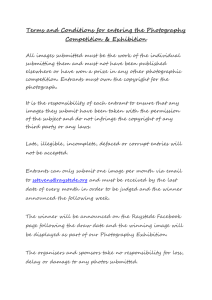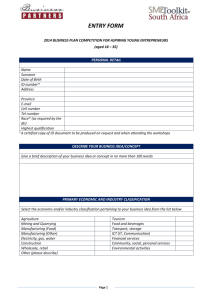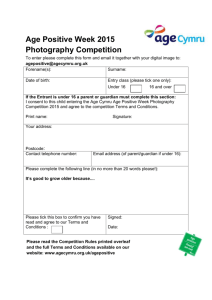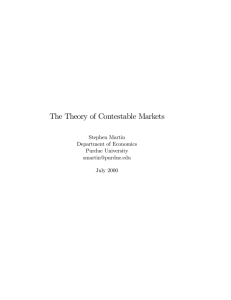Contestability
advertisement
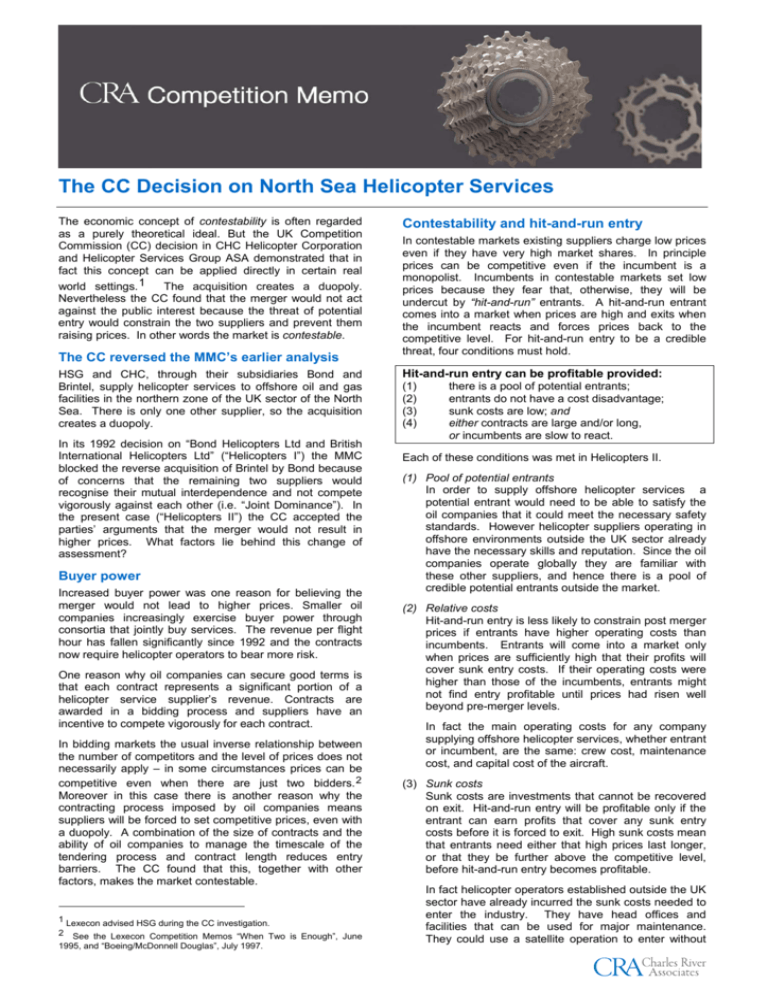
The CC Decision on North Sea Helicopter Services The economic concept of contestability is often regarded as a purely theoretical ideal. But the UK Competition Commission (CC) decision in CHC Helicopter Corporation and Helicopter Services Group ASA demonstrated that in fact this concept can be applied directly in certain real world settings. 1 The acquisition creates a duopoly. Nevertheless the CC found that the merger would not act against the public interest because the threat of potential entry would constrain the two suppliers and prevent them raising prices. In other words the market is contestable. The CC reversed the MMC’s earlier analysis HSG and CHC, through their subsidiaries Bond and Brintel, supply helicopter services to offshore oil and gas facilities in the northern zone of the UK sector of the North Sea. There is only one other supplier, so the acquisition creates a duopoly. In its 1992 decision on “Bond Helicopters Ltd and British International Helicopters Ltd” (“Helicopters I”) the MMC blocked the reverse acquisition of Brintel by Bond because of concerns that the remaining two suppliers would recognise their mutual interdependence and not compete vigorously against each other (i.e. “Joint Dominance”). In the present case (“Helicopters II”) the CC accepted the parties’ arguments that the merger would not result in higher prices. What factors lie behind this change of assessment? Buyer power Increased buyer power was one reason for believing the merger would not lead to higher prices. Smaller oil companies increasingly exercise buyer power through consortia that jointly buy services. The revenue per flight hour has fallen significantly since 1992 and the contracts now require helicopter operators to bear more risk. One reason why oil companies can secure good terms is that each contract represents a significant portion of a helicopter service supplier’s revenue. Contracts are awarded in a bidding process and suppliers have an incentive to compete vigorously for each contract. In bidding markets the usual inverse relationship between the number of competitors and the level of prices does not necessarily apply – in some circumstances prices can be competitive even when there are just two bidders. 2 Moreover in this case there is another reason why the contracting process imposed by oil companies means suppliers will be forced to set competitive prices, even with a duopoly. A combination of the size of contracts and the ability of oil companies to manage the timescale of the tendering process and contract length reduces entry barriers. The CC found that this, together with other factors, makes the market contestable. 1 Lexecon advised HSG during the CC investigation. 2 See the Lexecon Competition Memos “When Two is Enough”, June 1995, and “Boeing/McDonnell Douglas”, July 1997. Contestability and hit-and-run entry In contestable markets existing suppliers charge low prices even if they have very high market shares. In principle prices can be competitive even if the incumbent is a monopolist. Incumbents in contestable markets set low prices because they fear that, otherwise, they will be undercut by “hit-and-run” entrants. A hit-and-run entrant comes into a market when prices are high and exits when the incumbent reacts and forces prices back to the competitive level. For hit-and-run entry to be a credible threat, four conditions must hold. Hit-and-run entry can be profitable provided: (1) (2) (3) (4) there is a pool of potential entrants; entrants do not have a cost disadvantage; sunk costs are low; and either contracts are large and/or long, or incumbents are slow to react. Each of these conditions was met in Helicopters II. (1) Pool of potential entrants In order to supply offshore helicopter services a potential entrant would need to be able to satisfy the oil companies that it could meet the necessary safety standards. However helicopter suppliers operating in offshore environments outside the UK sector already have the necessary skills and reputation. Since the oil companies operate globally they are familiar with these other suppliers, and hence there is a pool of credible potential entrants outside the market. (2) Relative costs Hit-and-run entry is less likely to constrain post merger prices if entrants have higher operating costs than incumbents. Entrants will come into a market only when prices are sufficiently high that their profits will cover sunk entry costs. If their operating costs were higher than those of the incumbents, entrants might not find entry profitable until prices had risen well beyond pre-merger levels. In fact the main operating costs for any company supplying offshore helicopter services, whether entrant or incumbent, are the same: crew cost, maintenance cost, and capital cost of the aircraft. (3) Sunk costs Sunk costs are investments that cannot be recovered on exit. Hit-and-run entry will be profitable only if the entrant can earn profits that cover any sunk entry costs before it is forced to exit. High sunk costs mean that entrants need either that high prices last longer, or that they be further above the competitive level, before hit-and-run entry becomes profitable. In fact helicopter operators established outside the UK sector have already incurred the sunk costs needed to enter the industry. They have head offices and facilities that can be used for major maintenance. They could use a satellite operation to enter without incurring significant additional sunk costs, which would be limited to the legal costs of obtaining any necessary licences. (4) Reaction times and contract length Finally a hit-and-run entrant is unlikely to earn profits that cover its sunk entry costs if the incumbents can react quickly by reducing prices – and hence the entrant’s profits – when entry occurs. In markets where prices can change between transactions and where incumbents can react very quickly, hit-and-run entry may not be attractive even when sunk costs are very small. By contrast in a market where price is largely set as part of a long term contract the entrant’s revenue is determined by the terms of the contract it signs rather than by subsequent competition. An entrant can recover its sunk costs so long as its first contract is long enough or large enough. No matter how quickly the incumbent is able to react, the profitability of the entrant’s existing contract will not be affected once it is agreed. In Helicopters II, contracts were for a minimum of 3 to 5 years, and gave annual revenues of millions of pounds, compared to sunk costs of a few hundred thousand pounds. Together these factors mean that a rival not currently operating in the UK sector could enter profitably, in principle even for a single contract, if the incumbents did not offer competitive prices. Was there empirical evidence that this was possible in practice? No entry does not mean no constraint There have been some examples in helicopter services markets where a supplier has entered a new region for a one-off contract that was not subsequently renewed. It is fair to say, however, that these examples of what could be described as hit-and-run entry have been rare, which leads to the classic problem of how to interpret an absence of entry. One possible reason is that there are barriers to entry. The other possibility is that the market is so competitive that entry is not attractive. In Helicopters II, the CC concluded that the lack of entry was evidence of competitive pricing rather than barriers to entry and there was further evidence to support this conclusion. A natural experiment The North Sea provided a convenient natural experiment to test the hypothesis that a combination of the threat of entry and a competitive bidding process would be sufficient to prevent prices rising in the UK sector should the number of players fall from 3 to 2. The Norwegian sector of the North Sea was similar to the UK Northern Zone in all respects except one: there were three operators in the UK Northern Zone, but only two in the Norwegian sector. However there was no evidence that operators in Norway have been able to benefit from any reduction in competition as a result of the smaller number of active suppliers. A comparison of gross margins shows that contracts in Norway have not contributed any more to overheads than have those in the UK Northern Zone. The graph below compares the gross margin 3 per hour for all the contracts in the UK Northern Zone operated by the merging parties in the UK and of the contracts operated in the Norwegian sector by the two operators there. The results support the hypothesis that the intensity of competition in each region is not determined by the number of suppliers active there. 1.50 1.00 0.50 0.00 1995 1996 1997 1998 Years UK NORWAY Link to market definition In Helicopters II the CC defined a narrow market. It found high market shares but concluded that there was no competition concern because of the constraint offered by potential entrants. An alternative way to account for potential entry in cases like these is to widen the market or to adjust market shares in some other way. The US authorities in their merger guidelines refer to those companies which, although not in the market, have the potential to enter swiftly and easily, as “uncommitted entrants”. When calculating market shares the FTC and DoJ, in principle, treat these uncommitted entrants as though they were already in the market and make an “adjustment” to market shares to account for them. This adjustment is usually not numerical but is in the nature of a mental footnote that high share means less than usual. In Europe, competition authorities also recognise that “uncommitted entrants” can affect competition, and in some situations this is taken into account by widening the definition of the market. The most familiar instance is when the market is widened to include supply side substitutes. Exactly the same approach could have led the CC to widen the geographic market to include areas where potential entrants already operated. The aim of all these adjustments is to define the market in such a way that market shares encapsulate as much relevant information as possible about competitive constraints. Nevertheless, widening the market to include the locations and products of potential entrants is generally a blunt instrument for dealing with the observation that these suppliers constrain prices. In some cases, as here, the better approach is to acknowledge that high market shares do not always confer market power. Conclusions Contestability is often viewed as a theoretical ideal, a curiosity rather than something that is observed in real markets. The usual analysis of contestability focuses on markets where incumbents can react to entry very quickly. Helicopters II suggests that, if certain market conditions are present, markets where prices are set under long term contracts may come close to approximating the ideal of contestability. April 2000 © Charles River Associates (published originally by Lexecon Ltd, prior to the acquisition of Lexecon by Charles River Associates) 3 Revenue per hour for type S61N, minus salaries and fuel costs. Figures are relative to Norway 1995. London: Brussels: Amsterdam: Paris: 99 Bishopsgate, London EC2M 3XD Tel +44 (0)20 7664 3700, Fax +44 (0)20 7664 3998 Tel +32 (0)2 627 1400, Fax +32 (0)2 627 1444 Tel +31 (0)20 521 9326, Fax +31 (0)20 521 9333 Tel +33 (0)1 70 38 52 78, Fax +33 (0)1 34 29 67 40 For more information please contact: Dr William Bishop, Vice President (wbishop@crai.com) www.crai.com

